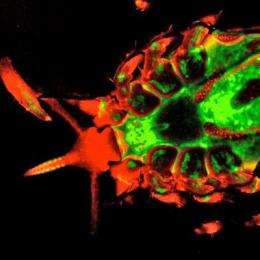On the trail of a vaccine for Lyme disease: Researchers target tick saliva

A protein found in the saliva of ticks helps protect mice from developing Lyme disease, Yale researchers have discovered. The findings, published in the November 19 issue of Cell Host & Microbe, may spur development of a new vaccine against infection from Lyme disease, which is spread through tick bites.
Traditionally, vaccines have directly targeted specific pathogens. This is the first time that antibodies against a protein in the saliva of a pathogen's transmitting agent (in this case, the tick) has been shown to confer immunity when administered protectively as a vaccine.
The Lyme bacterium known as Borrelia burgdorferi is transmitted by ticks. When it moves through the tick, it is coated with a tick salivary protein known as Salp15. The Yale team injected Salp15 into healthy mice and found that it significantly protected them from getting Lyme disease. When combined with outer surface proteins of B. burgdorferi, the protection was even greater.
Lead author Erol Fikrig, M.D. of Yale School of Medicine and Howard Hughes Medical Institute said, "The interaction between the Lyme disease agent and ticks is very complex, and the bacteria uses a tick salivary protein to facilitate infection of the mammalian host. By interfering with this important interaction, we can influence infection by the Lyme disease agent."
Several years ago there was a Lyme vaccine on the market that utilized just the outer surface proteins of the bacteria. It was taken off the market in 2002, and to date no other antigen has been tested in phase III clinical trials.
The authors believe this new strategy of targeting the saliva - the "vector molecule" that a microbe requires to infect a host - may be applicable not just to Lyme disease but to other insect-borne pathogens that also cause human illness.
"We believe that it is likely that many arthropod-borne infection agents of medical importance use vector proteins as they move to the mammalian host," Fikrig explained. "If so, then this paradigm, described with the Lyme disease agent, is likely to be applicable to these illnesses. Currently, we are working to determine if this strategy is likely to be important for West Nile virus infection, dengue fever, and malaria, among other diseases."
Source: Yale University (news : web)














